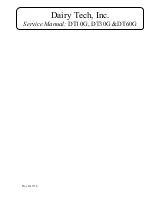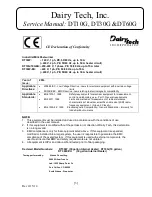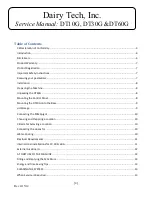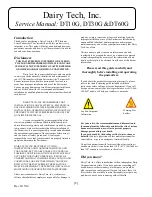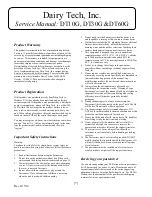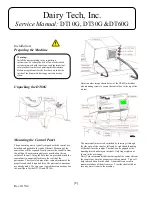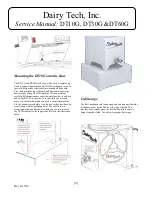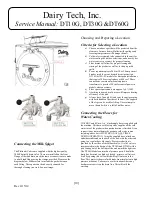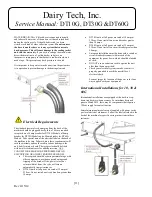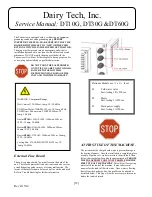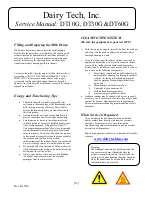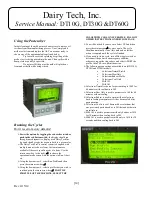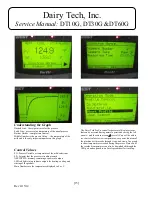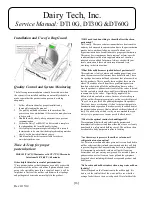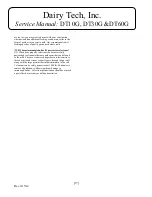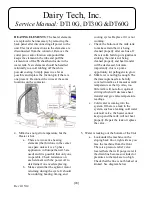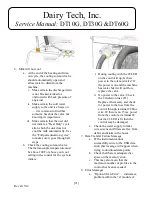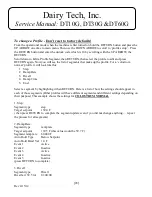
[13]
Rev 4/15/14
Dairy Tech, Inc.
Service Manual:
DT10G, DT30G &DT60G
Filling and Emptying the Milk Drum
While some dairies may elect to have the milk line pump
directly into the pasteurizer, most dairies will be dealing with
volumes that can be dumped into the unit from milk cans or
collection buckets. Try to avoid unnecessary splashing and
provide a sturdy step for short employees who may have
trouble comfortably dumping milk into the unit.
To remove the milk: Open the spigot to fill buckets, bottles or
storage bags. DO NOT TILT THE EQUIPMENT TO GET
MILK OUT! This may cause undue stress on the support
system and could potentially damage the unit or harm the
operator. Any residual milk or colostrum can easily be wiped or
brushed from the unit
Energy and Time Saving Tips
Pasteurize the milk as quickly as possible after
collection to take advantage of the heat already in the
milk to improve energy efficiency. This will also
prevent the immediate heavy growth of bacteria in
this fresh product.
Avoid placing the unit in an area of high drafts to
prevent convection heat losses while pasteurizing.
Colostrum can be stored in the refrigerator for an
extended period of time if it is handled cleanly once
it has been pasteurized. Filling Perfect Udder™
Colostrum management bags allows for a disposable
system that makes it easy to keep track of dates and
colostrum quality. These bags also allow the product
to be warmed more quickly when they are needed for
the newborn and can then be fed without
recontamination of the product. These can be ordered
at www.calfology.com or at www.dairytechinc.com.
Do not dip bottles into the tank for filling as this will
likely contaminate the product with bacteria from the
bottom and sides of the bottles.
Always wear nitrile or latex gloves when handling
the milk or colostrum to prevent the spread of
pathogens from the skin surface.
CLEANING THE SYSTEM
(Be sure the equipment is powered OFF)
With the stir motor stopped, raise the lid from the milk pot
and place it on the hook on either side of the unit after
thorough cleaning in a sink.
Clean the following milk surfaces with hot water and an
appropriate disinfectant. Go over all the exposed surface
areas with the included scrub brushes and appropriate
disinfectants. A mild abrasive pad may be used to remove
any residue on the following components:
Motor shaft, coupler and propeller (shaft can be
unthreaded for cleaning by grasping the coupler
with the slot facing forward and unthread the
shaft by grasping the knurling mid shaft for a
better grip.)
Thermocouple well at bottom of pot
Underside of the pasteurizer lid
Milk tank and drain spigot/valve
accessory spigots, pitchers or hoses
Stubborn residues may be cleaned with a scour sponge if
necessary. Avoid the overuse of acids as they may corrode
some of the brass or aluminum parts on the equipment.
Follow manufacturers handling recommendations for all
chemicals.
When Service is Required
If you purchased the Pasteurizer from an authorized
dealer, contact them directly with inquiries or repair
questions. For prompt service, work through the
troubleshooting guide in this manual to give an accurate
description of the problem.
Repair by an unauthorized service technician will void the
warranty.
Warning:
The aluminum and stainless steel drums and lids
can cause severe burns if handled before the
product is completely cooled. Always finish the
cooling cycle before handling the milk. Grasp the
lid by the handles and do not handle the milk or
colostrum unless it has cooled.
Содержание Platinum Series
Страница 2: ...2 Rev 4 15 14 Dairy Tech Inc Service Manual DT10G DT30G DT60G...
Страница 31: ...31 Rev 4 15 14 Schematic for Model DT10 30 60G 200 to 240VAC 1P 50 60Hz USA Domestic...
Страница 32: ...32 Rev 4 15 14 Schematic for Model DT10 30 60G 200 to 240VAC 1P 50 60Hz England Japan...
Страница 33: ...33 Rev 4 15 14 Schematic for Model DT10 30 60G 400VAC 3P Europe...
Страница 34: ...34 Rev 4 15 14 NOTES...
Страница 38: ...38 Rev 4 15 14...


